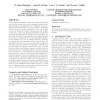Free Online Productivity Tools
i2Speak
i2Symbol
i2OCR
iTex2Img
iWeb2Print
iWeb2Shot
i2Type
iPdf2Split
iPdf2Merge
i2Bopomofo
i2Arabic
i2Style
i2Image
i2PDF
iLatex2Rtf
Sci2ools
KDD
2009
ACM
2009
ACM
Characterizing individual communication patterns
The increasing availability of electronic communication data, such as that arising from e-mail exchange, presents social and information scientists with new possibilities for characterizing individual behavior and, by extension, identifying latent structure in human populations. Here, we propose a model of individual e-mail communication that is sufficiently rich to capture meaningful variability across individuals, while remaining simple enough to be interpretable. We show that the model, a cascading non-homogeneous Poisson process, can be formulated as a double-chain hidden Markov model, allowing us to use an efficient inference algorithm to estimate the model parameters from observed data. We then apply this model to two e-mail data sets consisting of 404 and 6,164 users, respectively, that were collected from two universities in different countries and years. We find that the resulting best-estimate parameter distributions for both data sets are surprisingly similar, indicating th...
Data Mining | Electronic Communication Data | Individual E-mail Communication | Inferred Model Parameters | KDD 2009 |
| Added | 25 Nov 2009 |
| Updated | 25 Nov 2009 |
| Type | Conference |
| Year | 2009 |
| Where | KDD |
| Authors | R. Dean Malmgren, Jake M. Hofman, Luis A. N. Amaral, Duncan J. Watts |
Comments (0)

